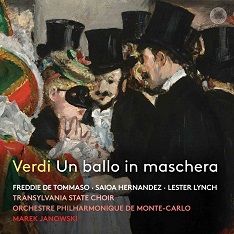Pentatone hat für den Janowski-Ballo aus Monte Carlo eine recht gute Besetzung zusammengestellt. Freddie De Tommaso beeindruckt mit der warmen Fülle der Stimme sowie einer guten Vokalführung über einen weiten Bereich. Von baritonal kräftiger Tiefe reicht die Stimme bis zu mühelos strahlender Höhe.
Zu den guten Eindrücken zählt auch der vitale und jugendlich frische Oscar von Annika Gerhards.
Die österreichische Mezzosopranistin Elisabeth Kulman singt eine prächtige Ulrica und hat die richtigen Farben und Nuancen, um die Rolle stimmlich wie darstellerisch voll auszuloten.
Die Amelia von Saioa Hernández kann sich in der internationalen Konkurrenz früherer Stimmen gut behaupten. Sie singt dramatisch und leidenschaftlich, auch wenn sie den singulären Rang einer Marias Callas bei weitem nicht erreicht. Aber wem gelang es schon wie Callas, dem vom Fatum gezeichneten Gesang der Amelia so zu charakterisieren?
Etwas enttäuschend ist unter den Hauptrollen Lester Lynchs Renato, der mir wegen etwas breit und gaumigem Gesangs nicht besonders gefällt.
Die gute Aufnahmetechnik stellt sodann das Dirigat von Marek Janowski in ein gutes Licht. Janowskis Spürsinn für feine Differenzierungen und orchestrale Farben lässt das Orchester aus Monte Carlo zu einer rundum überzeugenden Leistung ausspielen.
Meinen Favoriten für den Maskenball kann diese Aufnahme Dennoch nicht vergessen machen: Riccardo Mutis 1975er Aufnahme bei EMI mit Plácido Domingo, Piero Cappuccilli, Martina Arroyo und Fiorenza Cossotto, auch wenn ich punktuell Callas als Amelia und Bergonzi als Riccardo für unübertroffen halte.
Pentatone has assembled quite a good cast for the Janowski Ballo from Monte Carlo. Freddie De Tommaso impresses with the warm fullness of the voice as well as good vocal control over a wide range, from baritonally powerful low notes to effortlessly radiant high notes.
Good impressions also include Annika Gerhards’ vital and youthfully fresh Oscar.
Austrian mezzo-soprano Elisabeth Kulman sings a splendid Ulrica and has the right colors and nuances to fully explore the role both vocally and dramatically.
Saioa Hernández’s Amelia holds her own well among the international competition of earlier voices. She sings dramatically and passionately, even if she falls far short of the singular rank of a Marias Callas. But who has succeeded like Callas in so well characterizing Amelia’s fate-stricken singing?
Somewhat disappointing among the main roles is Lester Lynch’s Renato, whom I do not particularly like because of somewhat broad and palatal singing.
The good recording technique then puts Marek Janowski’s conducting in a good light. Janowski’s flair for fine differentiation and orchestral color lets the Monte Carlo orchestra play out to an all-around convincing performance.
Nevertheless, this recording cannot make me forget my favorite for the Masked Ball: Riccardo Muti’s 1975 recording on EMI with Plácido Domingo, Piero Cappuccilli, Martina Arroyo and Fiorenza Cossotto, even if I consider Callas as Amelia and Bergonzi as Riccardo unsurpassed.


















